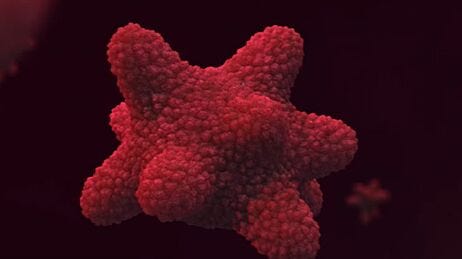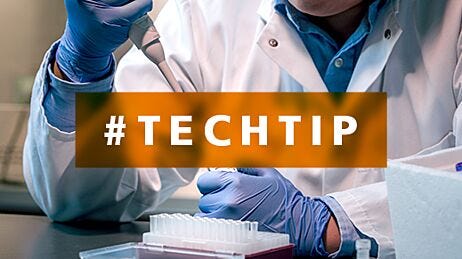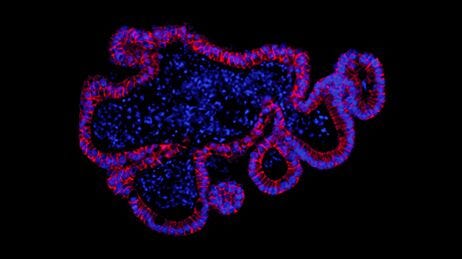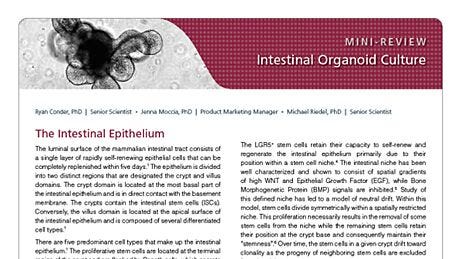Toxicity Testing for Drug Development Using Human Intestinal Organoids and IntestiCult™
Gastrointestinal toxicity is often a limiting factor in the development of therapeutic drugs, and traditional toxicity testing methods using immortalized cell lines or animal models may not show the true clinical effects1. Due to their increased complexity, intestinal organoids are a physiologically relevant in vitro cell model that can overcome the limitations of traditional methods for investigating intestinal epithelial cell biology and modeling disease2.
The following protocol provides a step-by-step guide for carrying out toxicity testing using intestinal organoids, providing researchers with the tools to effectively assess new therapeutic targets. Researchers working with specific applications may need to optimize this protocol further.
Materials and Reagents
- IntestiCult™ Organoid Growth Medium (Human) (Component A + Component B) (Catalog #06010)
- 25% bovine serum albumin (BSA) in phosphate-buffered saline (PBS)
- DMEM/F-12 with 15 mM HEPES (Catalog #36254)
- Corning® Matrigel® Matrix, Growth Factor Reduced (GFR), Phenol Red-Free (e.g. Corning 356231)
- Costar® 24-Well Flat-Bottom Plate, Tissue Culture-Treated (Catalog #38017)
- Costar® 96 Flat-Bottom Plate, Tissue Culture-Treated (e.g. Sigma CLS 3595)
- Falcon® 70 μm Cell Strainer (e.g. Corning 352350)
- Y-27632 (Catalog #72302)
Protocol
A. Preparation of Materials and Reagents
- Prepare complete IntestiCult™ Organoid Growth Medium (Human) as described in the Product Information Sheet.
- Prepare DMEM + 1% BSA as described in the Product Information Sheet.
- Pre-warm 24- and 96-well Costar® Tissue Culture-Treated plates at 37°C for 24 hours prior to use.
B. Expansion of Organoids
- Expand organoids in a 24-well plate according to standard protocols. Estimate 1 x 50 μL dome in a 24-well plate to seed 8 x 10 μL domes of a 96-well plate.
NOTE: This is an estimate only and should be adjusted based on organoid size and density.
- Grow organoids for 7 to 10 days, until they have reached full size, but have not begun to differentiate and shed dead cells.
- Follow standard protocols for passaging intestinal organoids present in the Product Information Sheet until step B.2.
- Centrifuge the sample at 200 x g for 5 minutes.
- Remove as much supernatant as possible and store on ice.
- Resuspend the organoid pellet in an appropriate amount of Matrigel® (10 μL per well to be seeded) and mix gently.
- Remove a pre-warmed 96-well plate from the 37°C incubator.
- Remove 10 μL of the organoid-Matrigel® solution from the tube and slowly, while keeping the pipette completely upright, add the 10 μL droplet to the center of the target well.
- Repeat for the remainder of the samples.
- Place the plate back in the 37°C incubator.
- Incubate for at least 15 minutes to allow for the Matrigel® to polymerize.
- Gently add 100 μL of IntestiCult™ OGM complete medium to each well.
C. Drug Treatment Protocol and Toxicity Testing
A 5-day treatment period allows for prolonged exposure, thereby demonstrating smaller growth inhibition effects. A longer growth phase and shorter treatment phase will highlight acute toxicity, but little growth inhibition.
GROWTH PHASE
- Grow organoids in 96-well plates for 2 days with IntestiCult™ OGM.
TREATMENT PHASE
- Prepare fresh aliquots of each medium/drug concentration to be tested, including a solvent control.
- On Day 3, replace the media in each well with the appropriate test medium and incubate for 2 days.
- Replace again on Day 5 and 7.
NOTE: If a drug has a short half-life, consider more frequent media replacements or reduce the duration of the treatment phase.
ANALYSIS PHASE
- On the final day of the selected treatment phase, image each well using either a Zeiss or STEMvision™ imager.
- Follow standard protocols for Promega CellTiter-Glo® 3D:
- Thaw reagent overnight.
- Replace media in each well with 100 μL pre-warmed DMEM/F12.
- Add 100 µL CellTiter-Glo® 3D reagent to each well.
- Incubate at room temperature (RT; 15 - 25°C) for 10 minutes.
- Mix each well vigorously with a pipettor (or a multichannel pipette) to resuspend the Matrigel® dome.
NOTE: Ensure that domes are completely suspended by inspecting each well visually. If complete or partial domes remain, repeat suspension.
- Transfer suspensions to an opaque white assay plate.
- Incubate at RT for 30 minutes.
- Measure luminescence as specified in the CellTiter-Glo® 3D technical manual.
Additional Resources
References
- Vlachogiannis G et al. (2018) Patient-derived organoids model treatment response of metastatic gastrointestinal cancers. Science. 359(6378): 920–26.
- Lynch S et al. (2019) Stem cell models as an in vitro model for predictive toxicology. Biochem J. 476(7): 1149-1158
Request Pricing
Thank you for your interest in this product. Please provide us with your contact information and your local representative will contact you with a customized quote. Where appropriate, they can also assist you with a(n):
Estimated delivery time for your area
Product sample or exclusive offer
In-lab demonstration







